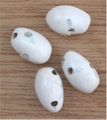Bean beetle
| Bean beetle | ||||||||||||
|---|---|---|---|---|---|---|---|---|---|---|---|---|

Bean beetle ( Acanthoscelides obtectus ) |
||||||||||||
| Systematics | ||||||||||||
|
||||||||||||
| Scientific name | ||||||||||||
| Acanthoscelides obtectus | ||||||||||||
| Say , 1831 |
The bean beetle ( Acanthoscelides obtectus ), also known as the bean beetle, is a species of leaf beetle from the subfamily of the seed beetles (Bruchinae).
While some related species infect legumes only in the field, the bean beetle can also reproduce in stored supplies of various legumes and is therefore considered a pest for storage in agriculture .
features
Bean beetles can grow to be 3.2 to 4.0 millimeters long and live in stores or outdoors. The body is predominantly black, the abdomen (including the pygidium ) mostly red. The first four and the last antenna link and the legs are also reddish, with the exception of the brown underside of the thighs . The body including the elytra is covered by a fine and dense hair (Vestitur) tawny, on the wing covers are embedded in generally three poorly demarcated brown cross bands. Characteristic are the wings, which do not completely cover the abdomen (pygidium), these are together a little longer than wide. They have flat, almost straight point stripes (striae) with a somewhat elongated puncture, the odd spaces between them (with the exception of the seam stripes) are a little wider than the even-numbered ones. The third and fourth stripes have small teeth at the base. The pronotum is triangular-bell-shaped, its surface sculptured by a fine dimple pattern. There is a flat impression near the back corners. There are three teeth on each thigh and the feet consist of four foot segments. The sexes can be distinguished by the formation of the fifth abdominal sternite: this is deeply outlined in the male, but only flat in the female. Newly hatched larvae have legs, later stages are legless.
Occurrence
The beetles and their larvae attack the seeds of legumes (Fabaceae). Primary hosts of the original occurrences in America are (New World) beans of the genus Phaseolus . In addition, seeds are adopted a variety of other species, including pigeon pea , chick pea , soybean , lablab , Lathyrus sativus , Lens , pea , broad bean , moth bean , mung bean , or saving Yellow No . The common bean beetle was introduced into Europe through imported beans. It is now common all over Europe. A single bean can contain up to 30 bugs. The bean beetle lays the eggs not only on fresh beans, but also on dried beans and other legumes.
biology
The female beetles living in the wild lay their eggs on the beans, preferring not the pods but the bean seeds themselves. In addition to exposed seeds, they cover those on the plant with partially opened pods. They also gnaw holes through the sleeve wall or seam themselves. A larva with legs hatches from the egg and eats its way into the seeds of the bean. The generation rate depends on the temperature; under favorable conditions, up to five generations are formed per year.
Bean beetle populations have a characteristic odor, which is due to an ester , which is believed to act as a pheromone . It is the allenic ester (-) methyl-n-tetradeca-trans-2,4,5-trienoate, which is formed by males.
supporting documents
- John M. Kingsolver: Handbook of the Bruchidae of the United States and Canada (Insecta, Coleoptera). United States Department of Agriculture, Agricultural Research Service Technical Bulletin Number 1912, November 2004. download
- ↑ Julius Kühn Institute : Identification aid for pathogens: pest portrait of the edible bean beetle. Retrieved February 20, 2017 .
- ↑ a b c K. W. Harde, F. Severa: Der Kosmos Käferführer: Die Käfer Mitteleuropas , 6th edition. Franckh-Kosmos, Stuttgart 2009, ISBN 978-3-440-12364-5
- ^ A b c M. Chinery: Parey's book of insects , 2nd edition. Franckh-Kosmos, Stuttgart 2012, ISBN 978-3-440-13289-0
- ↑ Acanthoscelides obtectus in Fauna Europaea. Retrieved May 3, 2013
- ↑ A. Szentesi: Pheromone-like substances affecting host-related behavior of larvae and adults in the dry bean weevil, Acanthoscelides obtectus. Ent. Exp. & Appl. , 1981
- ↑ DF Horler: (-) Methyl n-tetradeca -trans-2,4,5-trienoate, an allenic ester produced by the male dried bean beetle, Acanthoscelides obtectus (Say) , Journal of the Chemical Society. Vol. 1970, 1970


